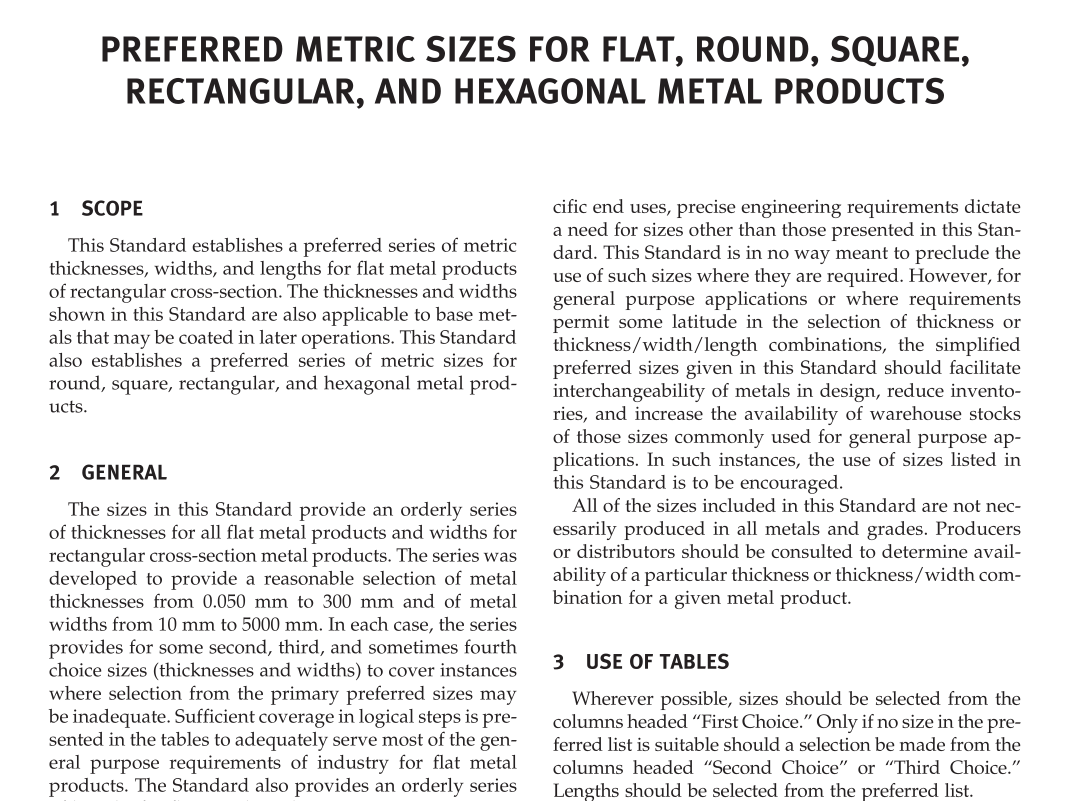ASME B32.100:2005 pdf free download Preferred Metric Sizes for Flat, Round, Square, Rectangular, and Hexagonal Metal Products
1 SCOPE This Standard establishes a preferred series of metric thicknesses, widths, and lengths for flat metal products of rectangular cross-section. The thicknesses and widths shown in this Standard are also applicable to base met- als that may be coated in later operations. This Standard also establishes a preferred series of metric sizes for round, square, rectangular, and hexagonal metal products.
2 GENERAL The sizes in this Standard provide an orderly series of thicknesses for all flat metal products and widths for rectangular cross-section metal products. The series was developed to provide a reasonable selection of metal thicknesses from 0.050 mm to 300 mm and of metal widths from 10 mm to 5000 mm. In each case, the series provides for some second, third, and sometimes fourth choice sizes (thicknesses and widths) to cover instances where selection from the primary preferred sizes may be inadequate. Sufficient coverage in logical steps is pre- sented in the tables to adequately serve most of the gen- eral purpose requirements of industry for flat metal products.
The Standard also provides an orderly series of lengths for flat metal products. This Standard also provides a series of sizes for each of round, square, rectangular, and hexagonal forms of metal products used for general applications. The series was developed to provide a reasonable selection of metal diameters from 0.020 mm to 320 mm for rounds and distance across flats from 3 mm to 300 mm for squares, various cross-section sizes from 1.6 mm by 2 mm to 100 mm by 200 mm for rectangles, and from 1.5 mm to 150 mm for hexagons. The series provides for some second, third, and fourth choice diameters for rounds and second and third choice distance-across-flats for squares and hexagons where selection from the primary preferred sizes may be inadequate.
The series also provides for preferred lengths of rounds, squares, rectangles, and hexa- gons. Sufficient coverage in logical steps is presented in the tables to adequately serve most of the general pur- pose requirements of industry for round, square, rectan- gular, and hexagonal metal products.
It is recognized that for some applications, particu- larly large volume requirements in some metals for specific end uses, precise engineering requirements dictate a need for sizes other than those presented in this Stan- dard. This Standard is in no way meant to preclude the use of such sizes where they are required. However, for general purpose applications or where requirements permit some latitude in the selection of thickness or thickness/width/length combinations, the simplified preferred sizes given in this Standard should facilitate interchangeability of metals in design, reduce invento- ries, and increase the availability of warehouse stocks of those sizes commonly used for general purpose ap- plications.
In such instances, the use of sizes listed in this Standard is to be encouraged. All of the sizes included in this Standard are not nec- essarily produced in all metals and grades. Producers or distributors should be consulted to determine avail- ability of a particular thickness or thickness/width com- bination for a given metal product.
3 USE OF TABLES
Wherever possible, sizes should be selected from the columns headed “First Choice.” Only if no size in the pre- ferred list is suitable should a selection be made from the columns headed “Second Choice” or “Third Choice.” Lengths should be selected from the preferred list. 4 BASIS OF TABLES The sizes in this Standard are derived from a list of pre- ferred metric sizes in which each number is approximately 60% greater than the number preceding it (ANSI B4.2 or ISO 497 Series R5). Second Choice sizes are in increments of 25% (Series R10?) and Third Choice sizes in increments of 12% (Series R20?). Some deviations from this principle occur as the result of minor rounding. The selected sizes also reflect standard material sizes in ISO and national standards in traditional metric countries. 5 TOLERANCES Material product tolerances are shown in applicable international or national product standards. Normal tol- erances shown in international standards are generally larger and could be up to twice as large for metric ma- terial compared with customary inch tolerances used in
ASME B32.100:2005 pdf free download
